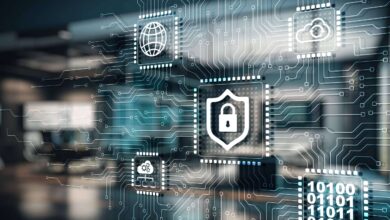Common Application Areas of AI in Fraud Prevention and Cybersecurity

You know what they say? It’s always a good idea to invest in cybersecurity and fraud prevention rather than pay for the consequences later. Especially now when there are all sorts of malicious risks, such as ransomware, trojans, or spyware tools. What’s worse is that with the rise of artificial intelligence (AI), fraud prevention and cybersecurity have become more important than ever. Models like the famous ChatGPT are easily accessible, which, in a sense, makes AI not a beneficial tool but more of a threat.
Why Cyber Attacks Continue to be a Serious Threat?
The line between the work-life balance is getting thinner by the minute since many people spend both their working hours and their free time online. On one hand, this connectivity level is full of benefits, we can share information, send transfers abroad, and so on. However, especially since the pandemic, we have seen poor statistics because a number of cyber attacks have skyrocketed and reached new heights.
But is cyber attack really that threatful? We dig deeper below.
Online Threats Continues to Evolve into More Complex Schemes
Cyber attacks are becoming a more serious problem as technology continues to advance rapidly, while security measures to protect this technology and its users are not improving as quickly. This gap in the cybersecurity sphere makes it an increasingly appealing target for hackers. Moreover, as people spend more time online—only stepping away from digital spaces when absolutely necessary—the risk and impact of cybercrime grow even larger than they were a decade ago.
Malicious Actors Use a Dual Strategy for Better Chances of Succeeding
If we had just a few methods for cyber attacks, we have a long list of never-ending techniques to conduct malicious activities online today. This is a pessimistic sign for companies that don’t invest in proper security measures, including classical prevention techniques such as implementing and adhering to compliance. As a result, bad actors use a dual strategy where they combine two types of malicious acts, making it difficult to detect the attack itself. A good example of this scenario would be attackers who use AI to create deep fakes and target specific organizations using personalized approaches that only apply to those businesses, making their success rate higher. This impacts businesses and their reputation adversely.
Where Do Humans Stand in the Context of Cybersecurity?
Even if we don’t want to admit this—often, people are the weakest links to cybersecurity. So, sometimes, even if the company invests in robust cybersecurity measures, mistakes happen, especially when humans aren’t robots—they can become an insider threat and use the company’s resources to sell data without the company knowing.
Additionally, our level of human reliance on the digital era has now made it a necessity to keep the space safe from fraud, attacks, and malicious disruptions that can damage data and other valuable content. Data protection and individual protection in the digital space are what cyber security has been all about.
In organizations with several employees, standardized security measures may not work effectively for everyone since people respond to security threats in different ways. A prime example of this is the issue of weak or reused passwords, a widespread human error in cybersecurity. Recycling passwords across multiple accounts or skipping monthly cybersecurity awareness training doesn’t help in this case either.
Does Automation Work in Preventing Fraud and Cyber Attacks?
Yes, it seems that the only effective way to actually detect and prevent fraud without putting all of the resources into a single sphere in business is to rely on some type of automation. AI-powered fraud detection software often uses high volumes of data mixed with advanced machine learning algorithms. That means, using this type of automation, businesses can spot the red flags and identify fraudulent activity.
That’s why many businesses today have turned to AI solutions to prevent fraud, as the fall of other businesses due to fraud has served as a great lesson on why they need to toughen their security. This approach involves training algorithms to detect patterns and irregularities that may indicate fraud. AI is also able to adapt to new fraud patterns and techniques continuously. It does this by analyzing historical, unlabeled data and trends and then making adjustments to its foundational models.
This capability for self-learning enables AI to effectively prevent emerging fraudulent activities, cyber threats, and identity theft, among other benefits that we discuss below:
Automatically Analyzing Large Amounts of Data
AI has stepped up cybersecurity through the analysis of large amounts of data in real time to identify abnormalities and patterns that can be used to detect fraudulent behavior. Years before the implementation of AI in cybersecurity, fraud detections did not detect fraudulent activities, as fraudsters did not circumvent the detection system that operated on predefined rules. AI has now made it super easy to detect subtle deviations from normal and flag potentially fraudulent transactions or activities going on in a system with a high rate of accuracy.
Verifying Multiple Third-Parties to Spot Shell Company Money Laundering
Companies often use the benefits of Know Your Business (KYB) solutions and integrate them to identify potentially fraudulent business partners. This helps avoid getting tangled up with companies that are linked to money laundering, such as shell businesses, that only exist on paper. In general, such KYB tools help businesses automatically collect and verify critical information such as addresses, ultimate beneficial owners (UBOs), and shareholders, assisting businesses in identifying potential money launderers and uncovering negative press coverage.
The complexity and high volume of transactions among third-party suppliers and business partners make these channels ideal for money laundering, as criminals can easily mix illicit funds with legitimate businesses. Since there are multiple steps and multiple transactions that need to be reviewed, the process of actually tracing the money back to its origin becomes extremely hard. Good thing that AI-powered KYB software can help organizations solve these issues and screen transactions efficiently and securely that doesn’t disrupt the experience for their clients.
Predicting Different Things Linked to Future Fraud Risks
It’s no secret that AI is capable of making assumptions about future trends, which is also a common use case example when talking about cybersecurity measures or tips linked to future fraud risks. In the cybersecurity landscape, there is a bunch of software created for this goal of detecting and preventing cybercrime, including examples like risk management tools and risk-scoring systems that evaluate users and their behavior on the digital platform. E-commerce sites can even use AI for better sales and track their users’ purchase history, then send out email campaigns to further suggest other items.
This means that AI can also help cybersecurity specialists ease their work as it assigns risk scores to transactions and activities based on their level of abnormalities. AI and machine learning find suspicious trends in transactions, score them using the level of risk, and prioritize the high-risk transactions for specialists to review and proceed with further investigation.
Final Thoughts
It seems that bad actors aren’t stopping anytime soon. With cyberattacks getting more complex and various fraud types reaching new heights beyond detection, financial institutions and other industries that have wide databases and cash flow should take a stand against the threats. That said, there’s no universal solution. AI-enabled tools like Business Verification can help detect fraudulent patterns and fake companies, but there are still standard security methods that you cannot miss, such as staff training and cybersecurity awareness.
The post Common Application Areas of AI in Fraud Prevention and Cybersecurity appeared first on Kratikal Blogs.
*** This is a Security Bloggers Network syndicated blog from Kratikal Blogs authored by Riddika Grover. Read the original post at: https://kratikal.com/blog/common-application-areas-of-ai-in-fraud-prevention-and-cybersecurity/



